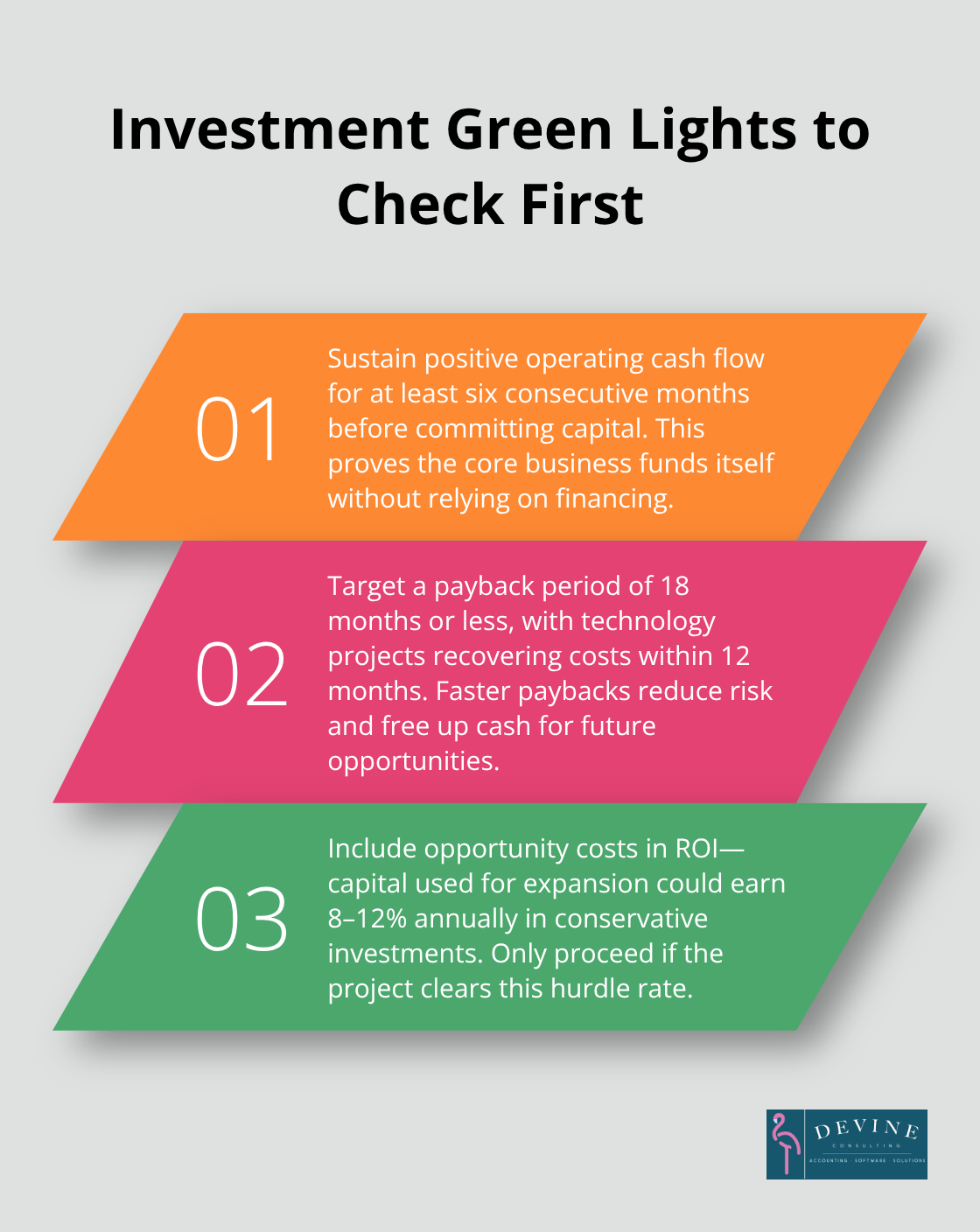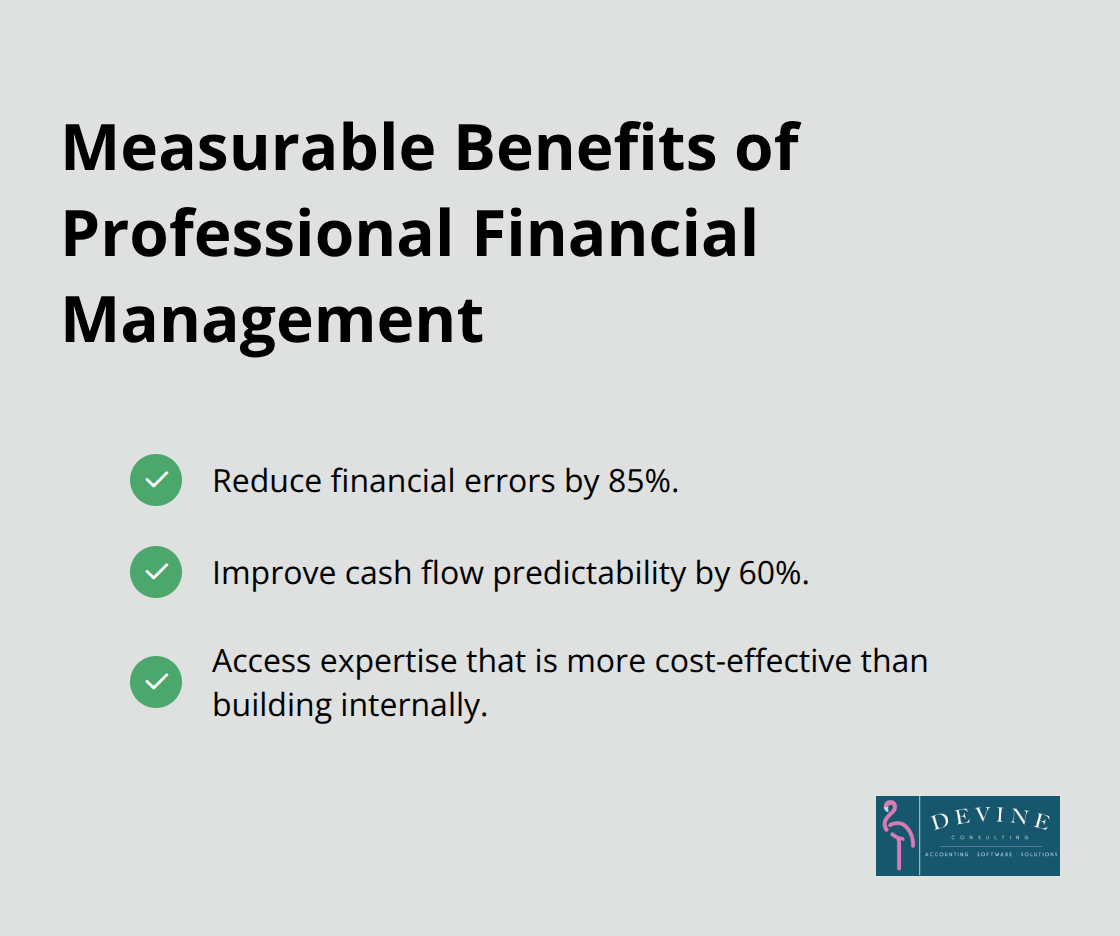Essential Finance Reports: What You Need to Know
Financial reports form the backbone of smart business decisions. Without understanding the different types of finance reports, companies risk making choices based on incomplete information.
We at Devine Consulting see businesses transform when they master financial reporting. This guide breaks down the essential reports every business owner needs to understand and use effectively.
What Reports Drive Business Success
The three financial reports that separate successful businesses from failing ones are the income statement, balance sheet, and cash flow statement. Companies that master these three documents make 73% better strategic decisions according to McKinsey research, while businesses that ignore them face a 40% higher chance of cash flow problems within two years.

Income Statement Shows Your Real Performance
Your income statement reveals whether your business actually makes money or just looks busy. This report tracks revenue, expenses, and net profit over specific periods (typically monthly or quarterly). The gross profit margin tells the most important story – firms face varying survival times during economic downturns, with median survival ranging from 8-19 weeks. Focus on the operating income line, which excludes one-time events and shows your core business performance. Revenue growth means nothing if your expenses grow faster, so track the expense-to-revenue ratio monthly.
Balance Sheet Reveals Financial Strength
The balance sheet shows what you own versus what you owe at a specific moment. The debt-to-equity ratio should not exceed 2.0 for most businesses to maintain financial flexibility. Current assets must exceed current liabilities by at least 1.5 times to handle unexpected expenses. Working capital (calculated as current assets minus current liabilities) determines whether you can pay bills without borrowing. Inventory turnover ratios above 6 times annually indicate efficient operations, while ratios below 4 suggest cash tied up in unsold products.
Cash Flow Statement Predicts Survival
Cash flow from operations must stay positive consistently – negative operating cash flow for three consecutive months signals serious trouble. The cash conversion cycle measures how quickly you turn inventory into cash and should decrease over time. Companies with cycles under 30 days enjoy significant competitive advantages. Free cash flow, calculated as operating cash flow minus capital expenditures, determines your ability to invest in growth opportunities or weather economic storms.
These three reports work together to paint a complete picture of your financial health, but reading the numbers correctly requires understanding key metrics and ratios that reveal the true story behind the data.
What Do The Numbers Really Tell You
The Essential Ratios That Matter Most
Financial ratios separate profitable businesses from those that head toward failure. The current ratio must stay above 1.5 – companies below this threshold face higher bankruptcy rates according to Altman Z-score research. Return on assets above 5% indicates efficient management, while anything below 2% signals poor resource allocation. The quick ratio (which excludes inventory) should exceed 1.0 for service businesses and 0.8 for manufacturers. Gross profit margins below 20% in most industries indicate pricing problems or cost control failures that require immediate attention.
Warning Signs That Predict Business Failure
Revenue that declines for two consecutive quarters while expenses remain flat creates a death spiral that affects many companies. Accounts receivable that grows faster than sales means collection problems – days sales outstanding above 45 days indicates serious cash flow risks ahead. Inventory levels that increase while sales decrease signal demand problems that typically worsen over time. Debt service coverage ratios below 1.25 mean loan payments consume too much cash flow, which limits growth opportunities and increases default risk.
Industry Benchmarks Reveal Your Real Position
Compare your metrics against industry standards, not just your own historical performance. Manufacturing companies average 8-12% net profit margins, while retail businesses typically achieve 2-4%. Restaurant industry food costs should not exceed 28-32% of revenue, with labor costs that stay under 30%. Professional services firms maintain gross margins of 60-80%, making lower margins a red flag for pricing or efficiency issues. Technology companies with recurring revenue models achieve 20-25% net margins, while traditional software sales generate 10-15% margins.
These benchmarks and ratios provide the foundation for smart financial decisions, but the real power comes from using this data to drive strategic business choices that help you understand the real story behind your numbers.
How Finance Reports Drive Smart Business Decisions
Budget Planning Requires Historical Data Analysis
Budget plans work best when you base decisions on trailing twelve-month data rather than single-quarter snapshots. Companies that allocate resources with comprehensive financial analysis can identify investments that produce delayed but real profits rather than just short-term accounting profits. Start budget plans three months before your fiscal year ends and use cash flow patterns to predict seasonal variations. Manufacturing businesses should allocate 15-20% of revenue toward capital expenditures, while service companies typically need 8-12% for technology and equipment upgrades. Track budget variance monthly – deviations above 10% in any category signal control problems that compound quickly.
Investment Decisions Demand Multiple Financial Signals
Growth investments require positive cash flow from operations for at least six consecutive months before you commit capital. The payback period for most business investments should not exceed 18 months (with technology investments that recover costs within 12 months). Return on investment calculations must include opportunity costs – money invested in expansion could generate 8-12% annually in conservative investments.

Companies with debt-to-equity ratios should aim for a healthy range typically between 25% and 40% while developing clear repayment plans. Working capital requirements often increase 15-25% during expansion phases, so factor this into investment plans.
Risk Management Starts With Financial Monitoring
Cash reserves should cover three months of operating expenses minimum, with seasonal businesses that maintain six months of coverage. Accounts receivable concentration above 25% from any single customer creates dangerous dependency risks that threaten business continuity. Monitor your quick ratio monthly – drops below 1.0 indicate liquidity problems that require immediate attention. Establish credit lines when financial ratios look strong, not when you need emergency funds. Companies that wait until cash flow problems appear pay interest rates 3-5 percentage points higher than those who secure finance proactively.
Final Thoughts
Monthly financial report reviews transform business operations from reactive to proactive management. Companies that analyze their types of finance reports consistently make faster decisions and avoid costly mistakes that plague businesses without current financial data. This systematic approach creates competitive advantages that compound over time.
Professional financial management delivers measurable results across all industries. Businesses that work with experienced accounting professionals reduce financial errors by 85% and improve cash flow predictability by 60%. The expertise required to interpret complex financial data often exceeds what internal teams can provide cost-effectively (especially for growing companies).

We at Devine Consulting help businesses across construction, oil and gas, and real estate industries achieve financial stability through comprehensive accounting solutions. Our team provides strategic financial planning and accurate reporting services that allow companies to focus on core operations while maintaining strong financial oversight. Consider partnering with professional accounting services that provide the expertise and systems needed to transform financial data into strategic business advantages.


